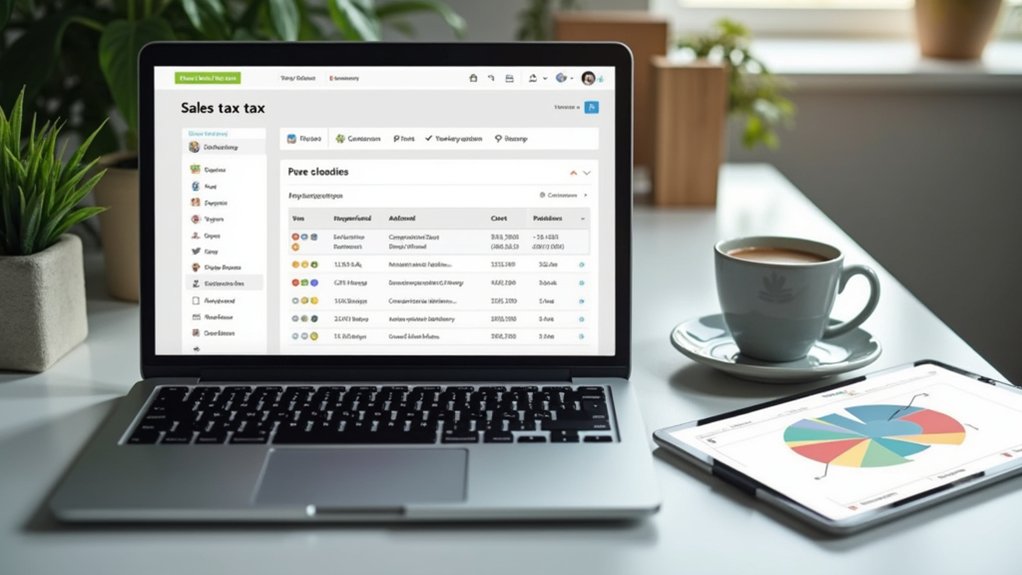Building a Shopify store involves a structured approach starting with identifying the target audience and sourcing trending products. Establish the right business structure, ensuring compliance with legal matters. Select a fitting Shopify theme to reflect the brand’s identity, then create essential pages like “About Us” and “Shipping Policy.” Configure payment and shipping options for customer convenience. Enhance marketing efforts and optimize the store for better performance. For an extensive guide, continue exploring further.
Key Takeaways
- Select a business structure and register it in compliance with local laws for a strong legal foundation.
- Customize a Shopify theme, ensuring it is mobile-friendly and aligns with your brand identity.
- Develop essential store pages like “About Us” and “Shipping Policy” to build customer trust.
- Configure payment options and shipping settings to enhance user experience and encourage purchases.
- Use SEO, social media, and email marketing to drive traffic and optimize store performance.
Finding Your Target Audience
Identifying the right target audience is a vital step in building a successful Shopify store, and it starts with a thorough analysis of demographics such as age, gender, income, and location.
This demographic insight forms the basis for understanding market demand and crafting a unique selling proposition. Engaging with communities on platforms like forums and Subreddits provides valuable consumer insights and trends.
By focusing on niche markets, businesses can differentiate themselves, addressing specific audience segments which fosters higher customer loyalty.
Target niche markets to differentiate and enhance customer loyalty.
Employing analytics tools is important for tracking customer behavior, enabling more precise targeting strategies. This data-driven approach guarantees that businesses connect effectively with their target audience, optimizing engagement and boosting sales conversion rates.
Ultimately, understanding the target audience is vital for sustained success.
Sourcing and Selecting Products
To effectively source and select products for a Shopify store, entrepreneurs should start by identifying trending products through forums and Subreddits, which offer valuable insights into consumer desires and prevalent market pain points.
Engaging with hobbyist communities not only uncovers niche-specific product ideas but also aligns offerings with the unique challenges faced by these audiences.
This strategic approach, combined with monitoring major marketplace trends, guarantees the selection of products that resonate with consumers and fill existing market gaps.
Identify Trending Products
Why do some products capture the market’s attention while others fade into obscurity? The key lies in the ability to identify trending products that align with current consumer preferences.
Successful online businesses, particularly those operating a Shopify store, thrive by sourcing products that meet the evolving demands of their audience. Conducting thorough market research is essential. Monitoring platforms like Amazon and eBay provides insights into popular selling products.
Dropshipping is a strategic option, offering flexibility by allowing sellers to offer trending products without inventory burdens. Additionally, staying updated with industry reports aids in adapting to market shifts.
Utilizing personal passions can also uncover niche products, ensuring a unique offering that stands out in a crowded marketplace.
Engage With Hobby Communities
After pinpointing trending products, savvy entrepreneurs can further refine their selection by engaging with hobby communities, an invaluable resource for sourcing niche products.
Platforms like Reddit and specialized forums allow online store owners to gain insights into trending product categories and challenges enthusiasts face. By actively participating in discussions, entrepreneurs can build credibility and gather feedback on potential products directly from their target audience, guaranteeing a better fit with consumer desires.
Additionally, social media groups offer a rich ground to discover underserved niche markets, enabling businesses to differentiate their offerings.
Monitoring product trends and analyzing sales data can help store owners find the right items to sell, refining their business model to attract customers effectively and verify inventory aligns with market demand.
Setting Up Your Business Structure
Establishing a solid business structure is a significant step in launching a successful Shopify store. Entrepreneurs must choose a business structure that aligns with their operational needs, whether it be a sole proprietorship for simplicity, a partnership for sharing resources, an LLC for personal asset protection, or a corporation for potential public funding.
Register your business in compliance with local regulations, which may involve obtaining specific permits or licenses. A tax ID number is essential for federal and state taxation, ensuring streamlined operations.
Trademarks are important for protecting your brand identity in the competitive marketplace. The chosen business structure will affect liability, taxation, and the ability to raise funds, making it imperative to align this decision with long-term business goals.
Choosing and Customizing a Shopify Theme
When initiating the journey to create a successful Shopify store, selecting and customizing the right theme is essential for establishing a strong online presence.
To begin, navigate to the “Online Store” section in the store builder and explore both free and paid themes that align with your branding needs. Make sure the theme settings are mobile-friendly since approximately 90% of users shop on their phones.
Customize your theme by adjusting colors, fonts, and layout to reflect your brand identity, ensuring visual coherence. High-quality images are vital for crafting an appealing storefront, capturing customer attention, and encouraging engagement.
Regularly update promotional messages and design elements to maintain a fresh, relevant appearance, enhancing conversion rates and customer loyalty.
Creating Essential Store Pages
To effectively establish an online presence with a Shopify store, creating essential informational pages is vital.
Key elements include an “About Us” page to foster brand connection, a “Shipping Policy” and “Return Policy” to set transparent customer expectations, and a “Terms and Conditions” page to outline the legal framework governing transactions.
Additionally, an “FAQ” page can enhance user experience by addressing common inquiries, ultimately streamlining customer service and boosting satisfaction.
Key Informational Pages
Crafting essential store pages is pivotal for establishing a credible and informative online presence on Shopify. Key pages such as the About Us, Contact page, Shipping Policy, and Terms and Conditions are indispensable for fostering trust in your brand and aligning with customer expectations. The About Us page narrates the brand story, connecting emotionally with customers. The Contact page offers multiple communication channels, enhancing customer support. A well-defined Shipping Policy manages expectations by detailing delivery methods and costs. Terms and Conditions provide legal protection by outlining policies on returns and refunds.
| Store Page | Purpose | Key Elements |
|---|---|---|
| About Us | Build trust and connection | Brand story, mission, values |
| Contact page | Enhance customer support | Email, phone, social media links |
| Shipping Policy | Manage customer expectations | Methods, costs, delivery times |
| Terms and Conditions | Provide legal protection | Policies on returns, refunds, responsibilities |
Policies and Terms
Building a robust Shopify store goes beyond creating aesthetic product pages; it involves developing thorough policies and terms that set clear expectations for both the business and its customers.
Vital pages include:
- Shipping Policy: Clearly outline shipping methods, shipping costs, delivery times, and geographical restrictions to inform customers before purchase, enhancing their buying experience.
- Return Policy: Specify conditions, timeframes, and costs for returns to build trust and minimize disputes, ensuring a successful online store.
- Privacy Policy: Explain data collection, usage, and protection, complying with GDPR and CCPA, maintaining transparency essential for customer trust.
- Terms and Conditions: Outline website rules, payment terms, user responsibilities, and transaction fees, providing legal protection.
An informative FAQ page further aids in addressing common queries, reducing customer service inquiries, and improving what customers see.
Configuring Payment and Shipping Options
When configuring payment and shipping options for a Shopify store, it’s vital to optimize these settings to enhance the overall customer experience and streamline the checkout process.
Shopify Payments can be managed through the “Finances” tab, allowing merchants to select preferred payment options like credit cards, PayPal, and Apple Pay. Considering transaction fees is important when choosing these options, as they impact profit margins.
Shipping options should be tailored to customer needs, offering flat rate, calculated, or free shipping for specific thresholds, thereby boosting satisfaction.
Accurate tax settings guarantee compliance with regional laws, automatically adjusting based on customer location.
Regular reviews of these configurations, informed by analytics and feedback, help optimize the checkout experience and minimize cart abandonment.
Marketing and Optimizing Your Store
Effective marketing and optimization strategies are essential for any Shopify store aiming to increase visibility and drive sales. To make the most of these strategies, store owners should consider the following steps:
- Optimize for Search Engines: Improve product descriptions, images, and meta tags to enhance the store’s ranking, as 70% of online shoppers search for products via search engines.
- Utilize Social Media: Direct traffic by targeting platforms where the audience is active, given that 73% of millennials are more likely to purchase from brands they follow.
- Create Engaging Content: Develop how-to videos or blogs, boosting lead generation threefold compared to traditional marketing.
- Implement Email Marketing: Use personalized campaigns to promote products, capitalizing on a higher open rate and nurturing customer connections.
Regularly analyze your store’s performance to refine strategies and improve conversion rates.
Frequently Asked Questions
How Do You Publish Your Online Store on Shopify?
To publish a Shopify store, finalize store settings, complete theme customization, and guarantee product listings are accurate. Confirm payment gateways and shipping options function correctly. Connect the website, optimize SEO, and develop marketing strategies before launching publicly.
How Much Does It Cost to Launch Shopify?
Launching a Shopify store typically costs between $500 and $2,000. This includes Shopify pricing plans, transaction fees, website registration, app subscriptions, themes costs, marketing expenses, and payment gateways. Shopify discounts can offset some expenses, enhancing affordability.
What to Do Before Launching a Shopify Store?
Before launching a Shopify store, one must conduct market research to understand the target audience, execute product sourcing, develop a branding strategy, design the website, perform competitor analysis, and establish a marketing plan while considering legal considerations.
How Do I Make My Shopify Store Active?
To activate a Shopify store, configure store settings, customize themes, and finalize product listings. Integrate payment gateways, set shipping options, and devise marketing strategies. Enhance customer support and utilize sales analytics for optimized conversion.
Conclusion
In summary, launching a successful Shopify store involves a strategic blend of understanding your target audience, meticulously sourcing products, and establishing a solid business structure. By selecting and customizing the right Shopify theme, creating essential store pages, and configuring payment and shipping options, entrepreneurs can lay a strong foundation for their online business. Continuous marketing efforts and store optimization are vital in driving conversions and ensuring long-term growth. This all-encompassing approach empowers business owners to thrive in the competitive e-commerce environment.




